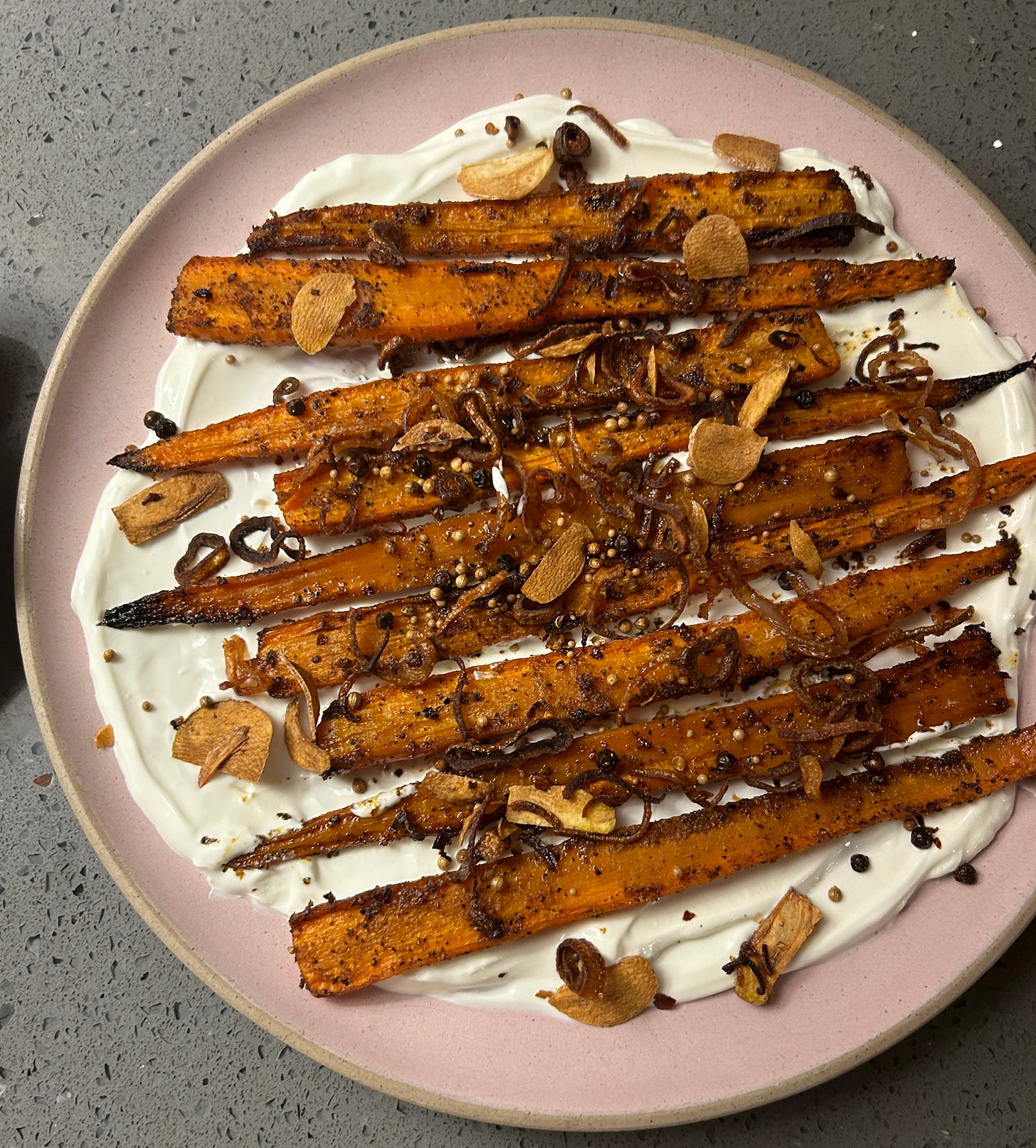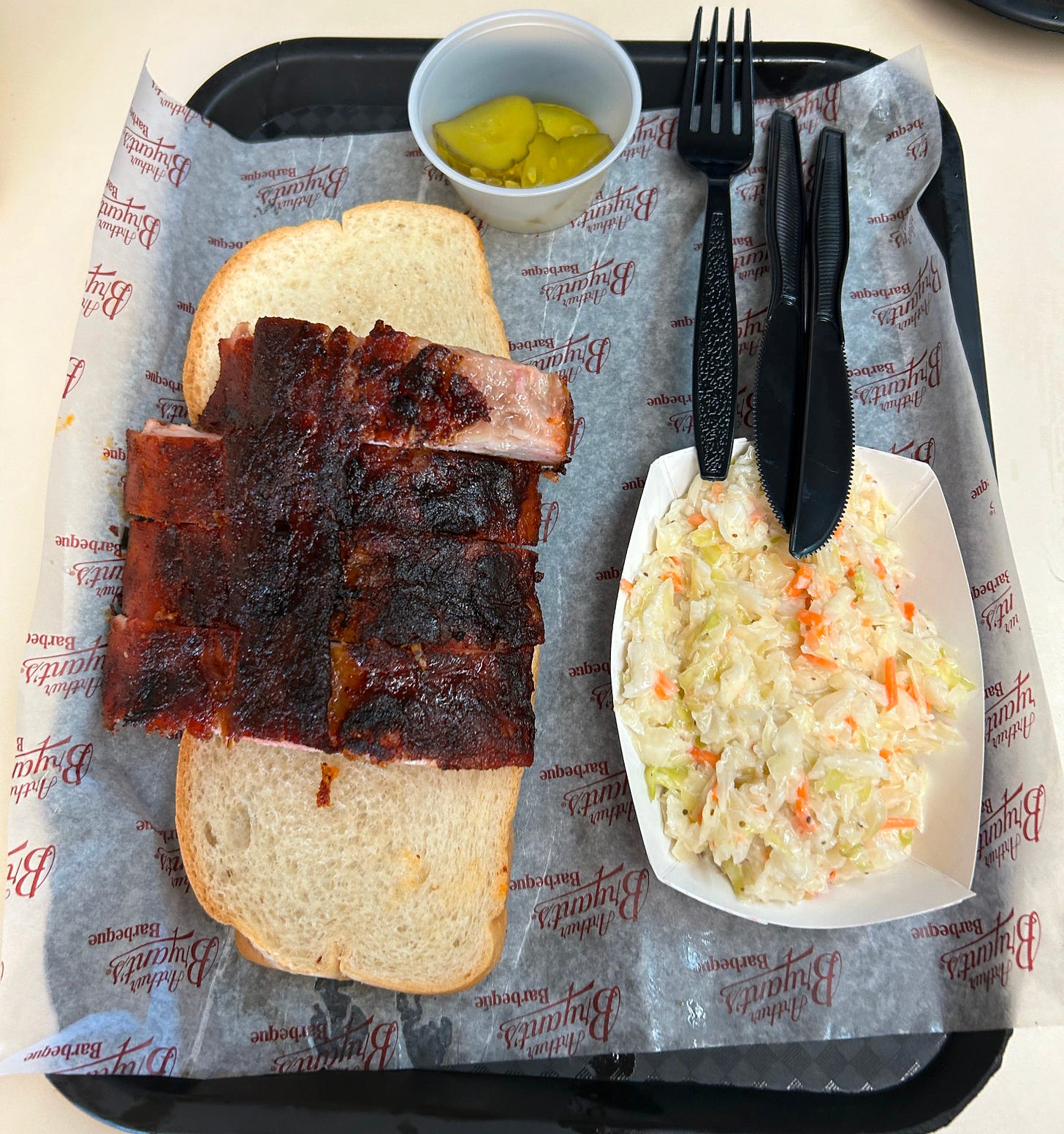Carrots, the Pastrami Flavor Nexus, and a Quick Smoked Meat Taxonomy
Happy Thanksgiving everyone
Hi friends, and Welcome to No Manners.
A project from me (Sam), designed by Phillip McClure.
I’ll have more to say soon, but at this very moment, there is a recipe burning a hole in my mind that needs to be shared in case you’re looking for one more vegetable dish to add to your Thanksgiving table, or something delicious for the days to come.
Like all good Thanksgiving dishes, it is based upon the autumnal bounty of vegetables and I think it deserves a seat at your table.
LET’S TALK PASTRAMI
But wait wait wait– first it’s time to talk pastrami. Growing up in North Carolina, my experience of pastrami was often insipid at worst, and at best I associated it with corned beef-like flavor, suitable for filling a sandwich, but nothing truly mouthwatering or singular. When I moved to Brooklyn, I realized that the full appeal of pastrami is truly realized not solely in its meatiness - no, the arcane deliciousness of pastrami lies in the nexus of beefy brisket unctuousness and warm spice headiness. Not too dissimilar from beef shawarma or lamb gyro - the spice blend, which on a pastrami creates a dark beautiful bark, to me is what takes a good pastrami to great, by complementing and balancing the smoky meat with a blanket of spices. Otherwise, we’re just talking about corned beef or Texas brisket (pastrami scholars, don’t come after me).I won’t jump into the full details of the history of pastrami, but suffice to say, like any good culinary history, it's fascinating, contentious, and involves a good bit of regional rivalry. Let’s take a quick break to look at my (highly subjective) taxonomy of delicious meats that I sketched on a plane, and Phillip made it look nicer.
No matter your opinion on the origin of pastrami, I think we can unilaterally declare the blend of spices used in the making of pastrami to be delicious, and well suited to complement other elements of a fall themed feast, Thanksgiving or otherwise. Roasted carrots, with their earthiness and sweetness, pair nicely with a pastrami rub, and the accompanying crispy shallot takes this recipe over the top for me. Some delis depend more heavily on the black pepper in the spice blend, but I personally enjoy balancing the blend with a nice bit of earthy coriander, mustard, and a touch of clove. If you’re up for making a pastrami at home, I heartily encourage you to do so, but there’s no need to confine our enjoyment of pastrami rub to beef. Get your carrots out and let’s eat!
CARROTS
2 pounds medium carrots, peeled and halved lengthwise
2 tablespoons grapeseed oil (or really any neutral oil)
1 tbsp molasses
FOR THE SPICE RUB
1 teaspoon ground cloves
1.5 teaspoon smoked paprika
1 tbsp kosher salt
2 tsp granulated garlic
1 tablespoon coarsely ground black pepper
1.5 teaspoon ground coriander
2 tbsp brown sugar
½ teaspoon ground mustard seeds
OPTIONAL BUT DELICIOUS
FOR THE FLAVORED OIL AND CRISPY SHALLOTS
1/2 cup grapeseed oil (or really any neutral oil)
1 tablespoon whole black pepper
1 tablespoon coriander seeds
1 tablespoon mustard seeds
2 thinly sliced shallots
3 cloves thinly sliced garlic
1 teaspoon chile flakes
OPTIONAL - ½ cup labneh or Greek yogurt
Carrots are delicious. Pastrami rub is delicious. Enough said. If you’re trying to make this quick on a weeknight simplification, you can always omit the flavored oil and crispy shallots
Instructions
Add all spices for the rub to a small bowl and mix well.
Preheat oven to 400F
Add carrots to a large bowl, then drizzle with the oil, then toss with the spice mixture, reserving 1 tablespoon.
Drizzle the molasses over the carrots and continue tossing to combine
Place carrots on a sheet tray, cut side down in the oven and roast for about 25 minutes depending on the size of the carrot and desired texture. Check for doneness by piercing with a fork or nibbling a piece.
While the carrots roast, place a small pot on the stove. Add the 1/2 cup of oil and sliced shallots and place heat on medium. When the shallots start to look browned and crispy, add the sliced garlic, fry for 60 seconds, then add the black pepper, coriander, mustard seeds and chile flake. Stir to combine and remove from heat and pour through a strainer reserving the crispy shallots and spices and the flavored oil separately.
Remove carrots from oven. Spread the yogurt or labneh on a plate, then plate the rest of the dish by placing the carrots on top, then use a slotted spoon to scatter the crispy shallots, garlic, black pepper and coriander on top. Drizzle with flavored oil as desired, and add extra pastrami seasoning if desired.
SAM’S SCIENCE TIP
It’s commonly known that carrots' orange color comes from a plant pigment called beta carotene, which is a precursor to Vitamin A synthesis in the body. But what’s lesser known is that by cooking carrots, you are actually drastically increasing bioavailability (the amount that’s actually absorbed and available for utilization) of that nutrient. Additionally, because beta carotene is an oil soluble compound, cooking in oil increases bioavailability as well. So next time someone tries to come at you with a raw veggie diet - let em know that cooking these carrots is delicious AND increases your intake of beta carotene.
***Source
In the kitchen, lately I can’t stop listening to Leif Vollebekk’s latest album - Revelation. It lives up to its name.
For food that I didn’t cook— this past weekend, I helped a friend drive a trailer from Montana to South Carolina (I hopped out in St. Louis to fly back). There wasn’t much time for good food on the trip (no shade thrown to my Taco Bell Crunchwrap) but we did manage to stop in Kansas City for a well-deserved lunch break, and based on some recon from a former KCian, we hit up Arthur Bryant’s for some classic KC BBQ.
That’s all for now!
Peace and Love to you, and Happy Thanksgiving!
—Sam









